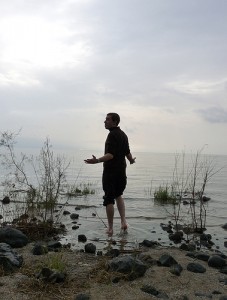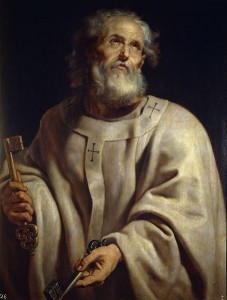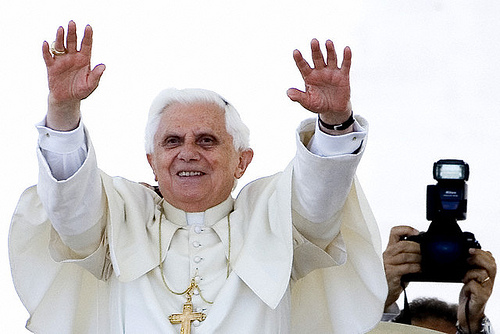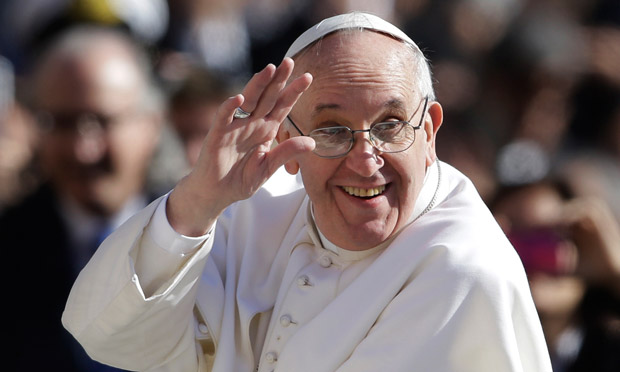
Peter was not the First Roman Pope
The Catholic Church Concocts History
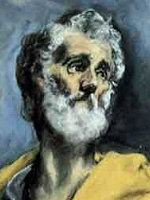 In the mid years of the second century the proto Christian Churches of the Mediterranean world were autonomous entities, with little doctrinal agreement among them. Churches in Asia Minor, Palestine, Egypt, Armenia, Rome and Syria had their own idiosyncratic interpretations of Christianity. Modern historians know most about Christianity in Rome, but Alexandria, Ephesus, and Antioch all had larger Christian communities.
In the mid years of the second century the proto Christian Churches of the Mediterranean world were autonomous entities, with little doctrinal agreement among them. Churches in Asia Minor, Palestine, Egypt, Armenia, Rome and Syria had their own idiosyncratic interpretations of Christianity. Modern historians know most about Christianity in Rome, but Alexandria, Ephesus, and Antioch all had larger Christian communities.
There was no universal canon to define doctrine other than the Old Testament. Each community wrote accounts affirming the correctness of their own beliefs. The Churches of the biggest cities manufactured succession lists of their own bishoprics. These lists allegedly proved that each bishop had consecrated his successor, and each list went back to one of the apostles. For example, Paul had supposedly lived in Antioch, and John, it was said, had lived in Ephesus. Caesarea, near Jerusalem, was where “Philip the evangelist” had lived. Eusebius reproduced these lists; however, many of them are proven forgeries and the others are very dubious.
Roman bishops were disappointed that Rome was not deemed the primary Christian authority in the empire. Their problem was that no one had manufactured Rome’s link with Jesus’ original apostles. They needed their own apostle, and someone chose Peter.
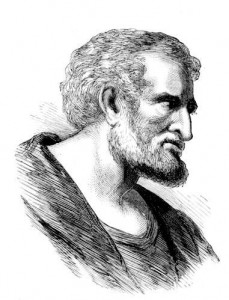 Peter was, in fact, an authoritative figure in the Nazarene movement, but content to firstly be under Yeshua’s leadership, and later under James’. Peter never became a purveyor of Paul’s philosophy (proto – Christianity.) Peter remained a Jew, a Nazarene, and a married travelling evangelist who respected the Torah. This much can be gleaned from the Gospels, and from Paul’s writings.
Peter was, in fact, an authoritative figure in the Nazarene movement, but content to firstly be under Yeshua’s leadership, and later under James’. Peter never became a purveyor of Paul’s philosophy (proto – Christianity.) Peter remained a Jew, a Nazarene, and a married travelling evangelist who respected the Torah. This much can be gleaned from the Gospels, and from Paul’s writings.
That is not how the Vatican portrays Peter. Those in the Vatican claim Peter was a Christian and that Peter became the first bishop of Rome, the first pope, and that Peter lived in Rome for
“…a long period.” (Catholic Encyclopedia.) They say Peter
“… was recognized as the Prince of the Apostles and the first Supreme Pontiff; his See, Rome, has thus enjoyed the position of primacy over the entire Catholic Church” (Catholic Encyclopedia.)
They contend Peter was crucified in about 64 CE and buried on Vatican Hill and that they now have his bones (an incorrect assertion discussed in my book.) They say that Peter’s authority has been passed on to all subsequent popes, (the so-called “apostolic succession”) who therefore represent the original Church as established by Jesus. I think all of this is rank fiction, and so does Dr Hugh Schonfield…
“According to the view which prevailed, the Catholic Church of the new orthodoxy was the inheritor of the true tradition of the Apostles, an assertion which illustrates the power of a lie if it is a thumping big one.”
To justify this
“thumping big lie,”
some “evidence” needed to be fabricated, preferably a ringing endorsement from Christ himself. It seems likely that someone inserted the following verses into the sixteenth chapter of Matthew: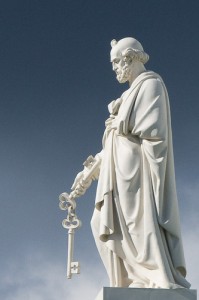
“But you, he said ‘who do you say I am?’ Then Simon Peter spoke up, ‘You are the Christ,’ he said ‘the Son of the living god.’ Jesus replied, ‘Simon, son of Jonah, you are a happy man! Because it was not flesh and blood that revealed this to you but my Father in heaven. So now I say to you: You are Peter and on this rock I will build my church. And the gates of the underworld can never hold out against it. I will give you the keys of the kingdom of heaven; whatever you bind on earth shall be considered bound in heaven; whatever you loose on earth shall be considered loosed in heaven. Then he gave the disciples strict orders not to tell anyone that he was the Christ” (Matt. 16:15–20, NJB.)
According to the Vatican, this was how Peter became the successor, the boss, and the man who stepped into Jesus’ shoes. The same section from Mark’s Gospel (which Matthew copied) does not contain this church/rock/key statement. No one can prove the lines in Matthew were an interpolation, yet the founding of a new (Christian) church hardly sounds like something Yeshua, a first century Jewish peasant, would say.
Many Protestant scholars go to great lengths trying to prove that Jesus did not want Peter to be pope,[1] and their arguments have much merit. Yet these Protestants usually are reluctant to put the above passage in perspective by admitting that it sounds like an unconvincing interpolation, as that would compromise their stance on the Gospels being the word of God.
An abridged version of the same idea that Jesus handed Peter a leadership role is also found in John’s Gospel, (this time moved forward to the very beginning of Jesus’ ministry) and with subtle differences:
“And when Jesus beheld him, he said, Thou art Simon the son of Jona: thou shalt be called Cephas, which is by interpretation, a stone. One of the two which heard John speak, and followed him, was Andrew, Simon Peter’s brother. He first findeth his own brother Simon, and saith unto him, we have found the Messiah, which is, being interpreted, the Christ. And he brought him to Jesus. And when Jesus beheld him, he said, Thou art Simon the son of Jona: thou shalt be called Cephas, which is by interpretation, a stone” (John 1:40–42, KJV.)
John’s Gospel says nothing about the founding of a church.
Vatican insiders claim the whole New Testament is the inspired word of God. So if New Testament writings contradict the Pope Peter story, the Vatican has some explaining to do.
It is pertinent to consider what the Bible has to say elsewhere about Peter.
Paul, who probably wrote in the 50s and early 60s, wrote nothing about Pope Peter. Paul implied Peter was a hypocrite, (Gal. 2:14[2]) hardly the sort of remark a devout Christian makes in passing about a pope.
Paul sent his famous Epistle to the Romans in the year 58 CE, in which he greeted more than twenty people, but Paul, the architect of Christian theology, sent no greetings to Pope Peter.
Paul went to Rome in 61 CE, and in 62–3 CE wrote to the Philippians, to the Colossians, the Ephesians, and to Philemon, yet he, once again, failed to mention Pope Peter.
Paul’s first epistle to the Corinthians contained a list of Christ’s resurrection appearances, the first of which is to “Cephas,” (Peter) so Paul did credit Peter with some status.
Paul wrote that James determined that Peter should act as a teacher, evangelizing to Jewish groups outside Jerusalem (Gal. 2:7.) There are an awful lot of places outside Jerusalem other than Rome.
In another letter Paul mentioned that Peter regularly travelled, with his wife, to various parts of the Roman Empire (1 Cor. 9:5.) So Paul portrayed Peter as a married travelling evangelist, and nowhere does Paul once mention anything about Peter being a Roman pope.
What about Peter’s story in the Gospels? Matthew’s “Peter /rock/ church” statement is not repeated in any of the other Gospels or epistles. Peter did not always understand Jesus, (John 13:7) and was hotheaded and impulsive, as when he allegedly cut off a servant’s ear in the garden of Gethsemane (John 18:10.)
All four Gospels have Peter deny an association with Jesus three times, which Peter later regrets.
All the Gospels depict Peter as a frequently fallible character, not a charismatic leader. Irrespective of whether Peter was or was not a “rock” in real life, if he were meant to be Jesus’ successor, the Gospel authors would have presented him in a more positive light.
What is more, nowhere, in any of the Gospels, did the other apostles acknowledge Peter as leader.
In Luke, Jesus said he did not credit any individual apostle with any particular status:
“A dispute arose also between them about which should be reckoned the greatest, but he said to them, ‘Among pagans it is the kings who lord it over them, and those who have authority over them are given the title benefactor. This must not happen with you. No; the greatest among you must behave as if he were the youngest, the leader as if he were the one who serves’” (Luke 22:24–26, NJB.)
The occasion of the argument was the night of the betrayal—the last night of Jesus’ life—and Jesus specifically stated that no one was to be in charge.
Acts, which is widely regarded amongst historians as largely fictional, portrays Peter as a Christian, a purveyor of Paul’s philosophy. Peter is said to have had a vision in which God instructed him to eat non-kosher meat, which might be seen as an amateurish attempt to make Peter not observationally Jewish. Peter was depicted as decisive and a miracle worker, quite different to the equivocating man in the Gospels. Peter delivered a significant sermon during Pentecost and took the lead in selecting a replacement for Judas Iscariot. Peter was twice arraigned, with John, before the Sanhedrin, directly defied them, and escaped from their clutches with the help of an angel. Peter undertook missionary journeys to Lydda, Joppa, and Caesarea, (Acts 9:32–10:2) and was instrumental in the decision to evangelize the Gentiles (Acts 10) at the Council of Jerusalem. About halfway through Acts, the author turned his attention away from Peter, and the Bible says nothing more about him. There is no bishop, prince or pope or Roman Peter in Acts. It seems probable that the portrayal of Peter in Acts as a Christian is a fiction, written after Peter passed on by someone promoting Christianity, but not early enough to incorporate the Pope Peter myth.
Nowhere in the epistles of Peter did the author, an early Christian who wrote in fluent Greek, claim any special role, authority, or power in a church, yet he signed himself as Peter. A Roman Pope Peter does not fit with what was originally written about Peter. Peter was a Galilean fisherman who could not speak Greek or Latin. It is plainly ridiculous to imagine an uneducated Jewish peasant from the backwater of Galilee who hated the Romans setting up shop in the capital of the Roman Empire. Peter would have been like a fish out of water.
James, not Peter, was the undisputed leader of the Nazarenes until his death in 62 CE. This is confirmed in Paul’s writing and in Acts, as well as many other non – Biblical sources such as the writings of Josephus, (who lived in Rome in the late first century) Jerome, and Eusebius. Peter was clearly subservient to James. Peter was not a descendent of David and not a relative of Yeshua or John the Baptist, so he did not have the proper pedigree for leadership. Between 62 CE and 135 CE, there was a succession of Jewish leaders of the Nazarenes who were all related to Yeshua and who ruled from Jerusalem, not Rome. Peter was not one of them.
If Yeshua existed, he was a Jew, and first-century Judaism was built around the temple. There were no Jewish churches. The idea that a hierarchy of pagans in Rome portrayed Jesus and his followers as Christians and then used Jesus’ name to decry Judaism, acquire power, money, and property, would have been repugnant to Yeshua.
A Pope Peter is not in accordance with what is known about the historical development of the Christian church hierarchy. Elders (Greek: presbeteros) led early Christian congregations; it is from them our modern words “presbyters” and “priests” are derived. As congregations grew larger, more presbyters were needed, and someone needed to be in charge. Bishops first appeared in some cities only around the end of the first century. As genuine records are so incomplete, it is not clear who first acted as bishop presiding over Rome.
The first explicit mentions of Peter ever having been in Rome only appeared after 170 CE, over one hundred years after Peter was supposed to have been there!
The Catholic encyclopedia states,
“We may conclude that Peter labored for a long period in Rome. This conclusion is confirmed by the unanimous voice of tradition which, as early as the second half of the second century, designates the Prince of the Apostles the founder of the Roman Church.”
An objective reading of this quote reveals that there is no documentary evidence that Peter worked in Rome until “as early as” at least one hundred years after his death!
How “unanimous” is this “voice of tradition?” This voice is never heard anywhere in the New Testament, most of which was written after Peter’s death. St Ignatius of Antioch, (35–110 CE) a church father, never stated that Peter was considered Rome’s first Christian leader. Polycarp, (70–~155 CE) bishop of Smyrna, (in modern Turkey) visited Rome. Polycarp is said by “tradition” to have known disciples of the original disciples of Jesus, yet he too failed to mention the existence of Prince Peter, or that Peter went to Rome. Papias, (70–163 CE) bishop of Hierapolis in Phrygia, (modern central Turkey) also neglected to mention that Peter ever went to Rome. Clement, who the Vatican claims was the fourth pope, says nothing in his letter about a Roman Prince Peter, nor does he mention that there was an established bishopric in Rome. Clement appears to have not known he was a pope! Justin, (100–165 CE) a key Catholic apologist, church father, and prolific author who lived in Rome in the mid-second century, never once even hints that Peter lived in Rome, or that a papal position even existed. The “unanimous voice of tradition” is a fiction!
The Catholic encyclopedia is basing its claim mainly on evidence from four authors—Dionysius of Corinth, (who wrote in 165 CE–174 CE, as quoted by Eusebius) Clement of Alexandria, (c. 190 CE, as quoted by Eusebius) Irenaeus of Lyons, (who wrote c. 177 CE) and Tertullian, who each state that Peter and Paul founded the Roman Church. These men wrote one to one and a half centuries after the probable time of Peter’s death. Their statements about Peter are only one or two lines in length. For example, Tertullian wrote:
“For this is the manner in which the apostolic churches transmit their registers: as the church of Smyrna, which records that Polycarp was placed therein by John; as also the church of Rome, which makes Clement to have been ordained in like manner by Peter” (Praescr. 1:22 [ANF 3:258]).
Irenaeus wrote:
“By indicating that tradition derived from the apostles, of the very great, the very ancient, and universally known Church founded and organized at Rome by the two most glorious apostles, Peter and Paul; as also [by pointing out] the faith preached to men, which comes down to our time by means of the successions of the bishops. For it is a matter of necessity that every Church should agree with this Church, on account of its preeminent authority, that is, the faithful everywhere, inasmuch as the tradition has been preserved continuously by those (faithful men) who exist everywhere” (Against Heresies, Book III, Chapter 3.)
Irenaeus was writing a little over one hundred years after the “glorious” Peter and Paul allegedly founded the “very great and very ancient” Church in Rome. Irenaeus, a man who actively promoted episcopacy, had to rely on “tradition” as a “matter of necessity” to explain Peter in charge in Rome. Irenaeus could not name any genuine source or facts about this so-called tradition, so his expletives were meaningless, other than that they suggest he was desperate to promote baseless assertions and the power of his own Church.
Paul himself wrote nothing about founding a Church in Rome in any of his letters and clearly tried to introduce himself to the already existing community in Rome in his letter to the Romans!
These four authors were fervent Catholic Christians and prolific writers. If they had known some genuine facts about a Roman Pope Peter, they would surely have documented them. Interestingly, these men may not have even written what is claimed, because gross interpolations and complete fabrications in the earliest writings of the Church Fathers commonly occurred in the second, third, and fourth centuries. Eusebius has been frequently discredited as a reliable recorder of other’s writings and of events (discussed in chapter 10 of the book.)
This means later (than the second century) claims of Peter’s sojourn in Rome are also almost worthless.
The evidence presented, questioning the authenticity of a leader Peter in Rome, leads one to question why such a fabrication may have occurred. By the second half of the second century, Christianity, in various forms, was a small, fragile, but empire-wide movement. Its organizational framework, and its central location, were not yet defined. The Roman Catholic Church felt threatened by prominent competition, particularly from Gnostics and Marcionites (neither group claimed there was a bishop Peter in Rome.) Other large cities in the empire with their own hierarchies and growing Christian populations were also a threat to Rome’s authority, so the Roman Church copied what most Christian communities in large cities did – contrived a list of bishops in an unbroken chain back to an apostle – in their case Peter.
The story of Peter’s presence in Rome was nothing more than a late second century fabrication designed to give the Roman Catholic Church precedence, prestige, and authority.
The first three “bishops” of Rome listed by “tradition”[3] are no more than names. The Catholic Church lists Clement I, who was probably a presbyter (not a bishop) from 91 CE to 101 CE, as the fourth bishop of Rome (despite the fact that Tertullian claimed Clement was ordained by Peter, which would make Clement the second pope.) Who then, were the Vatican’s second and third “bishops” of Rome, Linus (67–79 CE)[4] and Anacletus? (79–92 CE.)[5] Nothing is known about these two, other than their names, because like Peter, their supposed role as “pope” was fictional.
How long did “Bishop Peter” allegedly rule from Rome? We must move three hundred years forward to find out. St. Jerome (342–420 CE) wrote, without citing any evidence, that Peter ruled in Rome for twenty-five years. The Catholic encyclopedia does not advertise that Jerome wrote this in their carefully worded discussion about Pope Peter,[6] presumably because it is such a difficult claim to defend, yet admit it elsewhere.[7] It is much easier for the Catholic encyclopedia to call Peter’s Roman sojourn “a long period.” The encyclopedia does not give a start date or say for how long Peter’s bishopric lasted.
The early Catholics tried to further elevate Prince Peter’s status. Versions of Mark’s Gospel were in wide circulation and no one knew, or admitted they knew, who Mark was. This opened the door for the creation of another “tradition;” that Mark was the “companion of Peter.” Mark’s Gospel became, effectively, “the gospel that Peter would have written.”
Peter was never a Christian, never in charge, never a bishop in Rome, and had no connection with Mark’s Gospel. As best as can be ascertained, Peter remained true to his roots, a faithful Nazarene under the leadership of James. One of the world’s largest and wealthiest institutions, which has always claimed authority over the world’s Catholics, and sometimes the whole world,[8] is founded on a fabrication that became a tradition. People deserve to know this, not just because the Church Fathers were dishonest, but also because today’s papacy continues to promote an untrue myth about its own exalted beginnings.
[1] http://www.christiantruth.com/articles/mt16.html
[2] http://www.biblegateway.com/passage/?search=Galatians+2%3A14&version=KJV
[3] http://www.newadvent.org/cathen/12272b.htm
[4] http://www.newadvent.org/cathen/09272b.htm
[5] http://www.newadvent.org/cathen/01446a.htm
[6] http://www.newadvent.org/cathen/11744a.htm
[7] http://www.newadvent.org/cathen/05653a.htm
[8] http://www.biblebelievers.org.au/papal.htm
This guy is a fraud!
Ditto.


